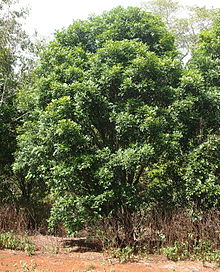Atalaya (plant)

Atalaya is a genus of eighteen species of trees and shrubs of the plant family Sapindaceae. As of 2013 fourteen species grow naturally in Australia and in neighbouring New Guinea only one endemic species is known to science. Three species are known growing naturally in southern Africa, including two species endemic to South Africa and one species in South Africa, Swaziland and Mozambique.[1][2][3][4][5][6]
One species A. salicifolia, which grows in Australia, has a wider distribution through nearby Timor and westwards through some more of the Lesser Sunda Islands (Indonesia).[2] This species has the widest distribution of all and is the type species—the first to have a formal scientific name, description and represent the genus.[7]
In biodiversity–rich New Guinea as of 2013, many areas do not have complete formal scientific botanical survey. In this context, science seems to have only recorded the knowledge of A. papuana growing there naturally as the putative sole endemic species. Regionally widespread A. salicifolia does not seem to have scientific records from New Guinea even though science has recorded it many times in the regions of northern Australia and Timor nearest to southern and western New Guinea.[4][7]
In mainland Australia’s warmer places, twelve species are known by published formal botanical descriptions—trees, shrubs and subshrubs, growing naturally in rainforests, brigalow scrubs, monsoon forests (rainforests in a climate of a summer wet season and cool dry season, with drought–deciduous trees), tropical savannas, coastal scrubs, some arid desert areas and in similar vegetation associations further south than the tropics.[6] Certain species particularly occur in Australia’s restricted areas of naturally high nutrient soil types, for instances, soils built from limestone or basalt parent materials. Areas of more fertile soils than average Australian soils, have not surprisingly had their native vegetation associations preferentially destroyed for converting the soils to European–Australian agricultural methods. This has disproportionately brought about the decline of the specialised native plants of these soils.[6]
Two Australian species found in Queensland have herbarium specimen collections and published informal descriptions, but are awaiting formal publication of scientific descriptions and names. Collectively, the fourteen known Australian species range throughout warmer parts of the continent, including parts of the semi-arid and arid zones, in Queensland, the Northern Territory, Western Australia, New South Wales and South Australia, except for Tasmania and Victoria where they have not been recorded.[6] Some Australian species have very reduced, scarce or isolated known ranges and natural habitats, as of 2013. Atalaya collina Yarwun Whitewood trees, have a known range of only two very isolated populations to the west of Gladstone, Queensland, hence this species’ populations have a national conservation status listing of “endangered” in the Australian government Environment Protection and Biodiversity Conservation Act 1999 (EPBC).[8]
